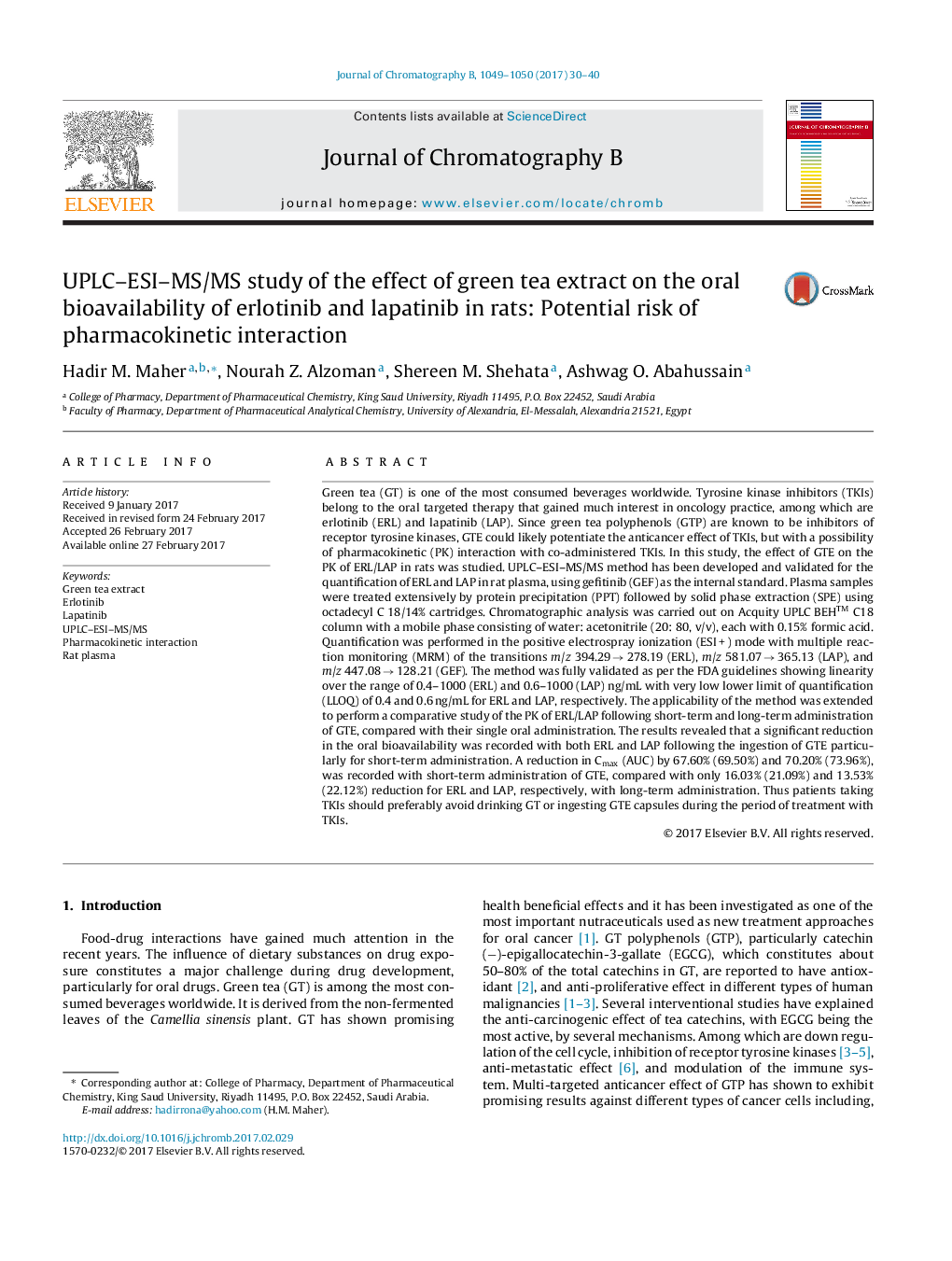| کد مقاله | کد نشریه | سال انتشار | مقاله انگلیسی | نسخه تمام متن |
|---|---|---|---|---|
| 5136630 | 1494012 | 2017 | 11 صفحه PDF | دانلود رایگان |

- It is the first time to study the effect of green tea (GT) on the pharmacokinetics of erlotinib and lapatinib in rat plasma.
- The proposed UPLC-ESI-MS/MS method was fully validated.
- The method offers great selectivity with low limits of quantification.
- The method has been successfully applied to pharmacokinetic interaction studies with GT following short and long-term administration.
Green tea (GT) is one of the most consumed beverages worldwide. Tyrosine kinase inhibitors (TKIs) belong to the oral targeted therapy that gained much interest in oncology practice, among which are erlotinib (ERL) and lapatinib (LAP). Since green tea polyphenols (GTP) are known to be inhibitors of receptor tyrosine kinases, GTE could likely potentiate the anticancer effect of TKIs, but with a possibility of pharmacokinetic (PK) interaction with co-administered TKIs. In this study, the effect of GTE on the PK of ERL/LAP in rats was studied. UPLC-ESI-MS/MS method has been developed and validated for the quantification of ERL and LAP in rat plasma, using gefitinib (GEF) as the internal standard. Plasma samples were treated extensively by protein precipitation (PPT) followed by solid phase extraction (SPE) using octadecyl C 18/14% cartridges. Chromatographic analysis was carried out on Acquity UPLC BEH⢠C18 column with a mobile phase consisting of water: acetonitrile (20: 80, v/v), each with 0.15% formic acid. Quantification was performed in the positive electrospray ionization (ESI + ) mode with multiple reaction monitoring (MRM) of the transitions m/z 394.29 â 278.19 (ERL), m/z 581.07 â 365.13 (LAP), and m/z 447.08 â 128.21 (GEF). The method was fully validated as per the FDA guidelines showing linearity over the range of 0.4-1000 (ERL) and 0.6-1000 (LAP) ng/mL with very low lower limit of quantification (LLOQ) of 0.4 and 0.6 ng/mL for ERL and LAP, respectively. The applicability of the method was extended to perform a comparative study of the PK of ERL/LAP following short-term and long-term administration of GTE, compared with their single oral administration. The results revealed that a significant reduction in the oral bioavailability was recorded with both ERL and LAP following the ingestion of GTE particularly for short-term administration. A reduction in Cmax (AUC) by 67.60% (69.50%) and 70.20% (73.96%), was recorded with short-term administration of GTE, compared with only 16.03% (21.09%) and 13.53% (22.12%) reduction for ERL and LAP, respectively, with long-term administration. Thus patients taking TKIs should preferably avoid drinking GT or ingesting GTE capsules during the period of treatment with TKIs.
Journal: Journal of Chromatography B - Volumes 1049â1050, 1 April 2017, Pages 30-40